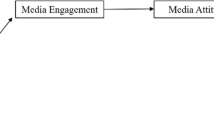Abstract
Imitating the look of an existing successful brand is a common occurrence in today's crowded marketplace. It was found that a negative experience with an imitator brand increased the evaluations of the original brand. A positive experience with the imitator was shown to have the opposite effect, and there was a decrease in the evaluations of the original brand. Subjects also indicated they would be likely to purchase the positive imitator over the original at only a 10 percent price reduction.
Similar content being viewed by others
References
A&M Pet Products v. Pieces, Inc., and Royak K-9 South West. (1989). United States District Court, Central District of Los Angeles, Case No. CV89-4923.
Bone, Paula Fitzerald, and Robert J. Corey. (1992). “Ethical Dilemmas in Packaging: Beliefs of Packaging Professionals.”Journal of Macromarketing (Spring), 45–51.
Elliot, Stuart. (1994). “Coca-Cola Freshens Up Ad Thrust.”Globe and Mail. Reprint fromNew York Times, November 10, p. B.
Feinberg, Robert M., and Donald J. Roussland. (1990). “The Economic Effects of Intellectual Property Right Infringements.”Journal of Business 63(1), 79–90.
Fitzell, Phillip B. (1982).Private Labels: Store Brands and Generic Products. Westport, CT: AVI Publishing Company.
LaBarbera, Priscilla, and David Mazursky. (1983). “A Longitudinal Assessment of Consumer Satisfaction/Dissatisfaction: The Dynamic Aspect of the Cognitive Process.”Journal of Marketing Research 20 (November), 393–404.
Loken, Barbara, Ivan Ross, and Ronald L. Hinkle. (1986). “Consumer Confusion of Origin and Brand Similarity Perceptions.”Journal of Public Policy and Marketing 5, 195–211.
Miaoulis, George, and Nancy D'Amato. (1978). “Consumer Confusion: Trademark Infringement.”Journal of Marketing (April), 48–55.
Oliver, Richard L. (1993). “Cognitive Affective and Attribute Bases of the Satisfaction Response.”Journal of Consumer Research 20 (December), 418–430.
Oliver, Richard L., and Wayne S. DeSarbo. (1988). “Response Determinants in Satisfaction Judgments.”Journal of Consumer Research 14 (March), 495–507.
Oppenheim, S. Chesterfield, Glen E. Weston, Peter B. Maggs, and Roger E. Schechter. (1983).Unfair Trade Practices and Consumer Protection: Cases and Comments. St. Paul, MN: West.
Schiffman, Leon G., and Leslie Lazar Kanuk. (1991).Consumer Behavior (4th ed.). Englewood Cliffs, NJ: Prentice-Hall.
Stern, Louis W., and Thomas L. Eovaldi. (1984).Legal Aspects of Marketing Strategy: Antitrust and Consumer Protection Issues. Englewood Cliffs, NJ: Prentice-Hall.
Ward, James, Barbara Loken, Ivan Ross, and Tedi Hasapopoulos. (1986). “The Influence of Physical Similarity on Generalization of Affect and Attribute Perceptions from National Brands to Private Label Brands.” In Terence A. Shimp et al. (eds.),American Marketing Educators' Conference (pp. 51–56). Chicago: American Marketing Association.
Zaichkowsky, Judith Lynne (1994). “The Personal Involvement Inventory: Reduction, Revision, and Application to Advertising,”Journal of Advertising 23(4) (December), 59–70.
Author information
Authors and Affiliations
Rights and permissions
About this article
Cite this article
Zaichkowsky, J.L., Simpson, R.N. The effect of experience with a brand imitator on the original brand. Market Lett 7, 31–39 (1996). https://doi.org/10.1007/BF00557309
Issue Date:
DOI: https://doi.org/10.1007/BF00557309



